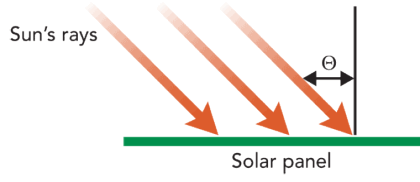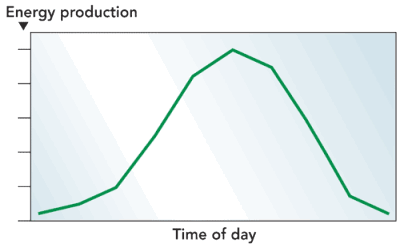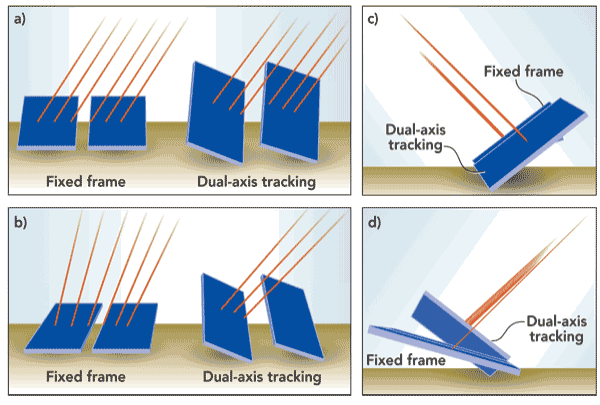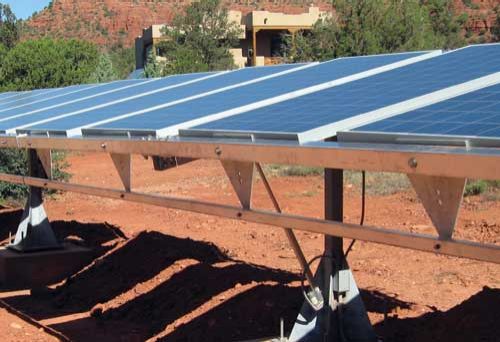Dual-axis tracking systems generate more power than fixed arrays by continuously positioning the PV array so that the incident angle of solar energy is 0°.
While a tremendous amount of research and funding is going into trying to increase the efficiency of photovoltaic cells by a few percentage points, there is a readily available solution that yields a 40% increase in produced power today - dual-axis tracking [1]. By simply moving the PV array so that it is aligned with the sun throughout the day and seasons, you get a large boost in produced power at a small incremental cost. Of course the cost depends on the design of the tracking system. In today's market, this cost ranges from under a $1.00/produced watt, to around $3.00/produced watt. Note that we are talking about produced watts rather than rated watts.
 |
|
Figure 1. Illustration showing the significance of the incident angle with respect to solar intensity and power production. |
The key to understanding the benefits of tracking is the significance of the incident angle, the angle at which the sun's rays strike the PV array. To see how the incident angle affects solar intensity and power production, we use the formula Intensity = Constant x cos Θ where Θ is the incident angle measured from perpendicular (Fig. 1). So intensity is at its maximum when Θ = 0−this is when the arriving energy strikes a PV panel perpendicularly. The greater the incident angle, the smaller the amount of energy reaching the panel.
Another consequence of a large incident angle is reflection. As the incident angle increases, the glass on the front of the PV panels begins to reflect energy away from the panels, reducing the power produced. The combination of reflection and reduced available surface area is why fixed solar systems produce very little power in the morning and afternoon. Figure 2 is a representational daily energy production graph for a fixed array.
 |
|
Figure 2. Representational daily energy production graph for a fixed array. |
For a fixed array, the incident angle changes throughout the day, from highly acute to highly obtuse. The result is that very little energy is produced during the morning and afternoon.
Tracking increases array performance
An optimally aligned dual-axis tracking system produces about 40% more power than an optimally aligned fixed-frame system [1]. Because it can tilt on both azimuth and zenith axes, a dual-axis tracking system follows the sun daily and seasonally, always positioning the array so that it optimally faces the sun.
Figure 3 illustrates the way dual-axis tracking works compared to a fixed frame. The figures were made by rotating a 3D digital model to capture different views of the panels.
In Fig. 3a, we see a fixed-array on the left and a dual-axis tracking system on the right. They are both set to true South and we can see that the lines representing the sun's rays coming into each array are at the same angle from horizontal. (This is a parallel projection so the panel shapes are distorted.)
 |
|
Figure 3. Illustration of dual-axis tracking: a) a fixed-array and a dual-axis tracking system both set to true South; b) panels tilted toward the sun in two directions, South and East; c) a view of the angle from the tracking array side; d) view from the fixed-array side |
In Fig. 3b, we see that the panels in the tracking array are tilted towards the sun in two directions - South and East, and we see that the incident angle is 0° for the tracking array and greater than 0° for the fixed array. Note that changing from a parallel projection to single-point perspective corrects the panel shapes, but distorts the parallelism of the rays.
In Fig. 3c we can see the angle from the tracking array side. The tracking array is tilted toward the South so, again, the incident angle is 0° and the array is generating maximum power.
 |
|
Figure 4. Representational graph of the power produced by a dual-axis tracking array superimposed over the graph of a fixed-array. |
Looking at Fig. 3d from the fixed array side, we see that the incident angle is greater than 0° for the fixed array, so it is receiving less than full solar energy. When we combine the North/South and East/West "errors" for the fixed array, the decrease in the energy the array is receiving is significant.
Figure 4 is a representational graph of the power produced by a dual-axis tracking array superimposed over the graph of the power produced by a fixed array. The area between the curves represents the additional power generated with dual-axis tracking.
Shading and spacing
Shading, spacing and the aspect ratio of PV panels are interrelated considerations for tracking systems. In the early morning and late afternoon when the sun is low in the sky, the panels in an array would have to stand almost vertically to directly face the sun. As the panels in the array rotate up from horizontal, they create a higher and higher profile. This profile on one panel eventually causes shading on the panel behind it. The closer the rows of panels are together, the sooner shading will occur. While the rows of arrays could be spread far apart, at some point shading will always occur as the sun approaches the horizon.
 |
|
Figure 5. The InteliTrack Balanced/Frame design. The actuator moves the array in the north/south plane and the pivot bar (attached to bottoms of triangles) moves the array in the east/west plane. |
Backtracking is used to mitigate shading. It is done by rotating the panels back from their optimal position facing the sun. This creates a small incident angle, but allows the array to produce more power than if the panels were slightly shaded.
Financial impact of dual-axis tracking
Because dual-axis tracking generates 40% more power from each panel, you can achieve the same power output with 29% fewer panels, frames and so on, which reduces a project's upfront costs and offsets to a great extent the additional cost for tracking hardware [2]. On the other hand, you can use the same number of panels as originally planned and generate 40% more power and higher revenues. This reduces the project's payback time by a little less than half and also increases the overall return on investment (ROI), depending on the financial specifics of the project.
Better tracker design
One of the drawbacks of most dual-axis trackers has been the pole-mounted design. Most tracking systems are pole-mounted in a manner similar to satellite or radar dishes. Because the array is hung from a single point, gravity is always trying to pull them over and their wind load factor is quite high. This requires heavy-duty mechanisms to hold and position the array and massive, heavy concrete foundations, heavy-duty earth moving equipment and cranes to set the array in place − all increasing the cost of installation. Another disadvantage to pole mounting is the height which can be anywhere from 12' to 20', forcing the arrays to be widely spaced to avoid shading.
A better design would be lightweight, low wind resistance, and no requirement for an extensive foundation to support it. One solution is the InteliTrack (Fig. 5), which holds the PV panels in balance, like a gimbaled ship's compass, allowing the panels to tilt in two directions around their own axes. This design eliminates the need for a huge foundation since there is no stress from gravity or a high wind load on the supports. It is made of aluminum so it is lightweight and, without a heavy foundation, suitable for rooftops and parking lot shade structures as well as for large ground-mounted utility projects. Wind loading is greatly diminished because of its low profile and the fact that the panels can be louvered to present only a thin edge to the wind.
Acknowledgments
InteliTrack and Balanced/Frame are trademarks of Sedona Energy Labs.
References
1. Percentages derived using the NREL Solar Advisor Model tool by using identical input data, but varying the type of system among fixed frame, single-axis tracking and dual-axis tracking.
2. Panel reduction is derived by the formula: 1 - (100% /(100% +40%)) = 28.57%, where 40% is the increase in power production.
Mark Scanlon received a BA degree in biology from Northern Arizona U. and has done graduate studies in electrical engineering at Northern Arizona U. as well as graduate work in solar and sustaining design at the Wright Ingraham Institute (under full scholarship). He is CEO of Sedona Energy Labs, 2225 N Gemini Dr., Flagstaff, AZ 86001 ph.: 928-863-3245; email mark@sedonaenergylabs.com.
Past PVWorld Issues